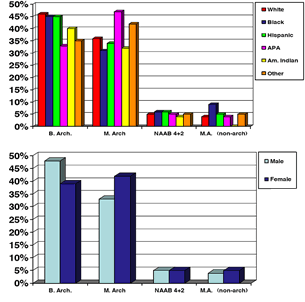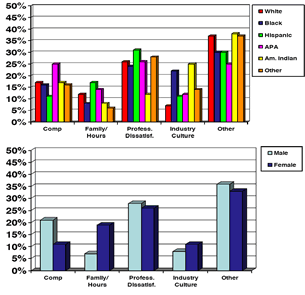

2/2006

by Tracy Ostroff
An audit of existing research and demographic data concerning the architecture profession conducted by the Holland & Knight Corporate Diversity Counseling Group for the AIA affirmed what many believed through anecdote and perception: that the barriers to diversity within the profession are remarkably similar to those identified as barriers to the growth of the profession in general. The authors call the report a “significant first step” in a process of “systemic, persistent, long-term efforts to diversify the profession that will require cultural transformation across the continuum of architecture education, internship, licensure/registration, practice, and professional development.”
The four-phase study responds to a resolution passed in 2004 by delegates to the AIA national convention in Chicago “To Strengthen the Demographic Diversity of the Design Profession.” Among other items, the measure called for the Institute to “collaborate with related architectural organizations and support research initiatives and ongoing data collection that will lead the profession to a better understanding of who enters in the profession and why.” The findings of this report and other studies conducted in 2004 and 2005 will be used to inform diversity initiatives in 2006 and 2007. The findings identify three key recommendations as integral to transformation of the profession:
- Expanding the path to practice
- Improving licensure rates and reducing attrition
- Ensuring equal opportunities in the profession.
Phase 1: Analysis of existing demographic data on the profession
The report considered demographic information on registered architects,
including that kept by the Census and the U.S. Bureau of Labor and
Statistics, the AIA, collateral organizations like the National Council
of Registration Boards, and others.
Although there is keen interest in the type of data that would inform the study, “there is no comprehensive demographic data on the profession in terms of race/ethnicity, gender, and age, and no information on sexual orientation and disability that is maintained by any of the collateral organizations,” or any other source that Holland & Knight surveyed, “except to the extent the Census and Bureau of Labor Statistics data purports to be reflective and comprehensive of the architecture profession. Additionally, a lot of the existing demographic data are unreliable and/or unavailable.” The lack of demographic data, they say, is a result of long-standing policies, the legal concerns of state and collateral organizations, and inconsistent collection methods.
While “The AIA collects, manages, and stores basic professional and demographic data on architects, interns, and other non-licensed architecture professionals,” the numbers cited in the report only reflect the architect members of the Institute’s membership, which the report counts as about half of all registered architects in the U.S.
The analysis also considered a review of information on registered architects, including that kept by the Census and the U.S. Bureau of Labor and Statistics and the AIA, as well as a literature review of the online directory of Black architects and NOMA; research on female architects by Kathryn Anthony, Hon. AIA; ACSA data on architecture faculty; the 2003 Internship and Career Survey, which was conducted jointly by the AIA and ArchVoices; and NAAB data on architecture students, as well as consideration of demographic information and existing research on women and minority architects in the United Kingdom, Canada, and Australia.
Phase 2: Review of findings and analysis of independent research on
the demographics of the profession
The researchers launched a Web-based survey in the spring of 2005. Second,
both demographically diverse and homogeneous focus groups were conducted
at the AIA national convention in Las Vegas in 2005, as well as in Chicago,
New York City, and Washington, D.C. In addition, 55 one-on-one interviews
were conducted with a broad demographic cross-section of architecture
students and professionals, both traditional and nontraditional.
Holland & Knight identifies certain limitations in the data collected in Phase II. “These are confined to the quantititave data collected in the Web-based survey, where there are known inconsistencies and/or inaccuracies in that some respondents failed to provide consistent responses, perhaps through inattention or misunderstanding.” The extent of this phenomenon cannot be defined with any certainty, the researchers report. Nevertheless, the authors note, “the overall findings and conclusions that are contained in the report provide valuable insight into the demographics of the architecture profession on a scale not previously available, as well as the reasons underlying the demographics of the profession.” The authors also explain they have made an effort to explain the differences where certain demographic groups appear to be over-represented in the survey replies.
The authors highlight these findings:
 Highest degree attained. The majority of respondents had either
a BArch (45%) or MArch (36%). Only 5% of respondents had an accredited
pre-professional architecture degree as their highest degree and 4% had
a graduate degree in another field of study. Female respondents (42%)
were most likely to hold a MArch as their highest degree, while male
respondents (48%) were most likely to hold only a BArch.
Highest degree attained. The majority of respondents had either
a BArch (45%) or MArch (36%). Only 5% of respondents had an accredited
pre-professional architecture degree as their highest degree and 4% had
a graduate degree in another field of study. Female respondents (42%)
were most likely to hold a MArch as their highest degree, while male
respondents (48%) were most likely to hold only a BArch.- First consideration of architecture as a career. Male respondents were significantly more likely than female respondents (37% vs. 28%) to have first considered architecture as a career before high school. Conversely, females were nearly 40% more likely than males to have first considered architecture as a career in college (22% vs. 16%) and were 60% more likely than males to have first considered architecture as a career at some "other" time (8% vs. 5%).
- Time to complete IDP. Overall, more than two-thirds of respondents (67%) completed the IDP in 4 years or fewer. Male and female respondents had roughly equivalent IDP completion rates in 3 years (28% males vs. 29% females) and more than 6 years (9% males vs. 10% females). However, nearly twice as many males completed the IDP in fewer than 3 years than females (20% vs. 11%) and slightly more females than males completed the IDP in 4—6 years (46% females vs. 38% males).
 Primary
reason for not practicing. More
than one-third of overall respondents (35%) not practicing or not intending
to practice architecture as a career identified “other” as
their primary reason for not practicing. The second most commonly cited
reason for not practicing was “professional dissatisfaction” (20%),
comprising “lack
of job satisfaction” and “erosion of the architect’s
role in the building industry,” followed closely by “compensation” (18%).
Across gender there were two significant differences in the response
rate to this question. Nearly twice as many male respondents rated “compensation” as
their primary reason for not practicing as female respondents (21%
vs. 11%). Conversely, female respondents rated “personal/family
circumstances” and “inflexible
hours” as their primary reason for not practicing at a rate nearly
3 times the rate of male respondents (19% vs. 7%).
Primary
reason for not practicing. More
than one-third of overall respondents (35%) not practicing or not intending
to practice architecture as a career identified “other” as
their primary reason for not practicing. The second most commonly cited
reason for not practicing was “professional dissatisfaction” (20%),
comprising “lack
of job satisfaction” and “erosion of the architect’s
role in the building industry,” followed closely by “compensation” (18%).
Across gender there were two significant differences in the response
rate to this question. Nearly twice as many male respondents rated “compensation” as
their primary reason for not practicing as female respondents (21%
vs. 11%). Conversely, female respondents rated “personal/family
circumstances” and “inflexible
hours” as their primary reason for not practicing at a rate nearly
3 times the rate of male respondents (19% vs. 7%).- Current/anticipated career path. Overall, 77% of respondents identified their current or anticipated career path as “traditional architecture.” Another 10% of respondents identified their current or anticipated career path as “non-traditional architecture,” which was defined as not-for-profit architecture organizations, associations, facilities management, and consulting. The remaining respondents were split among “nonarchitecture-related careers” (4%); “academia/teaching” (4%); “allied fields” (3%), defined as including interior, industrial, or graphic design; and “construction/engineering” (2%). The most commonly cited “non-architecture related careers” were real estate and development. Only .3% of respondents identified as “landscape architects.”
- Licensure/registration.
 Overall,
nearly two-thirds of respondents (64%) were
licensed/registered. Of those survey respondents who were not licensed/registered
(36%), 84% said they intended to seek licensure/registration. However,
whereas 69% of White respondents were licensed/registered, only 45%—48%
of respondents of every other racial/ethnic group were licensed/registered,
with no appreciable difference among the various racial/ethnic
groups. There was also a significant difference in the licensure/registration
rates among male and female respondents. Although 73% of male respondents
were licensed/registered, only 45% of female respondents were licensed/registered.
Overall,
nearly two-thirds of respondents (64%) were
licensed/registered. Of those survey respondents who were not licensed/registered
(36%), 84% said they intended to seek licensure/registration. However,
whereas 69% of White respondents were licensed/registered, only 45%—48%
of respondents of every other racial/ethnic group were licensed/registered,
with no appreciable difference among the various racial/ethnic
groups. There was also a significant difference in the licensure/registration
rates among male and female respondents. Although 73% of male respondents
were licensed/registered, only 45% of female respondents were licensed/registered.
Other Phase 2 findings
The discussion points posed in focus groups and one-on-one interviews
formed the basis for the report’s qualitative analysis, which
developed around seven themes:
- Under-representation of women and minorities within the profession
- Importance of diversity to the architecture profession
- Insufficient role models in the profession for women and minorities
- Barriers to diversity in the architecture educational experience
- Inequality of opportunity in professional practice
- Attrition of women and minorities
- Barriers to licensure/registration and declining interest in the pursuit of traditional architecture careers.
Phase 3: Data collection over time
Holland & Knight recommends that the architecture profession look
to demographic data collection models suggested by the legal, medical,
and engineering professions. “It has been suggested that NCARB
collect demographic information because it is the gatekeeper of the profession.
However, Holland & Knight’s research suggests that, in general,
licensing bodies such as NCARB do not take on that role. Generally, such
information is collected by voluntary professional associations and membership
organizations. Holland & Knight offers that NAAB require schools,
as a condition for renewing their annual accreditation, should provide
the organization with certified reliable and verifiable information,
with NAAB reviewing the data, preparing statistical reports, and making
the information available to the AIA and the public by posting on their
Web sites. Holland & Knight also proposes that the AIA “aggressively
continue to collect demographic data on its existing members, as well
as on the intern population” during annual membership renewals
and through periodic surveys of the membership and to work with state
and local components to collect demographic data.
“By continuing to aggressively increase its membership, aggressively register interns through the Emerging Professional’s Companion, and utilize the student information collected by NAAB, within the next 10 years the AIA should have a reasonably detailed picture of the architecture profession that it can use to create programs and better allocate resources,” Holland & Knight note.
Phase 4: Environmental scan
The report sought to place diversity in the context of the many factors
that will influence the architecture profession over the next two
decades. These were not comprehensive, however they provide an overview
of some of the most pressing and pervasive issues the architecture
profession is likely to face in the coming two decades. They are grouped
into seven categories: technology, the expanding role of non-architects
in design and construction, social/political trends, licensing trends,
demographic trends, economic outlook, and compensation trends. “It
will be important to continue to support research and data collection
over time in order to continually update the Institute’s understanding
of the issues affecting future professionals.”
Now that the report has been reviewed by the AIA Board, the national component has undertaken to integrate its recommendations into its programs. In 2006, this includes:
- Establishing a compendium of best practices from state, local, and regional components’ programs designed to expand the diversity of the profession and the AIA membership
- Making additional adjustments, as needed, to existing programs at the AIA national convention, K-12 education, architecture education, mentorship, and emerging professionals to address a number of the issues identified in the Demographic Data Audit Final Report
- Working with the collateral organizations to develop and implement a comprehensive data collection and analysis system to continually track the diversity of the professional over time
- Developing and disseminating a “workshop in a box” program on the results of the data audit for use by components
- Establish a digital archive of work and other materials by architects from underrepresented groups. This will be undertaken in collaboration with Knowledge Resources and the eKnowledge initiative
- Completing a comparative analysis of the Demographic Data Audit results, the 2005 Internship and Career Survey, the AIA Member Census, the 2004 Non-member Survey, The 2006 Firm Survey, and other data available from the U.S. Department of Education.
“The 2005 Demographic Data Audit was a significant first step. There is little disagreement across the profession of the value of diversity and to need to encourage and develop individuals from under-represented groups as architects and as leaders,” said Andrea Rutledge, managing director of the AIA’s Alliances team. “The Institute is committed to moving forward with initiatives to support and encourage individuals from under-represented groups to join the profession and continuing to educate clients—current and potential—of the value diverse perspectives and experience bring to their projects.”
Copyright 2006 The American Institute of Architects.
All rights reserved. Home Page ![]()
![]()
![]()